![]()
![]()
![]()
Use LEFT and RIGHT arrow keys to navigate between flashcards;
Use UP and DOWN arrow keys to flip the card;
H to show hint;
A reads text to speech;
14 Cards in this Set
- Front
- Back
|
DOGMA |
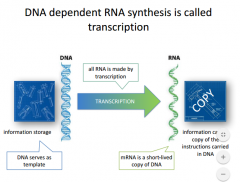
DNA is transcribed into RNA which is translated into protein. |
|

|
B. Gene B is also using the top strand as a template. The opposite strand is called the coding strand. |
|
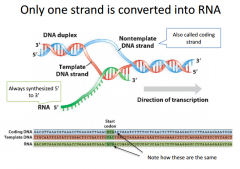
|
Start codon on DNA is converted into RNA is the ATG. The start codon on the RNA is is AUG.On the template, it's TAC because we need to build a sequence off of it. The RNA we are making is complementary to the template strand but equivalent to the coding strand. |
|
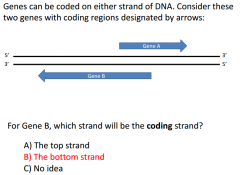
|
B |
|
|
What are the 3 steps to transcription? |
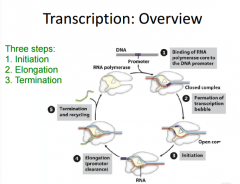
1. Initiation: How we start transcription & recruit RNA poly to the DNA 2. Elongation: Happens really fast. Time period that polymerase is moving along the template strand to synthesize DNA 3. Termination: How transcription is terminated. We only want to synthesize part of gene that will become mRNA. |
|

|
The whole composition is a holoenzyme. A holoenzyme is the state in which polymerase (green), sigma factor (blue) and DNA (red) function best. This begins the initiation process. Initiation won't begin with just the RNA polymerase without sigma factor bound to DNA. |
|
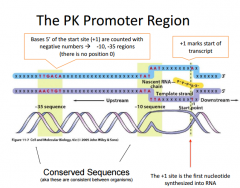
|
The A on the top right is where we start transcription. It's called the +1 site. Moving upstream (left), we reach the -10 region then the -35 region. These sequences are important for the sigma factor to recognize it. The RNA polymerase can kind of bind DNA but it does it in a non-specific manner. We need some level of specificity, and this is possible with the -10 and -35 regions. |
|
|
-10 and -35 sites |
The sigma factor will bind both regions simultaneously. These two regions are called conserved regions because a lot of organisms will have a very similar sequence. Changing these regions will weaken the site and make it a weak promoter. A strong promoter is one that has the best match (sequence) for sigma factor and the gene is more likely to be expressed. |
|
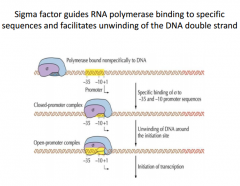
|
DNA polymerase binds to the sigma factor because it does a bad job on it's own to bind to the DNA. Sigma factor can slide along the genome and will sit at the promoter region, will bind tightly if the region matches the sequence well. From this, we get to a closed promoter complex then an open promoter complex. |
|
|
Closed Promoter Complex |
The sigma factor and RNA polymerase have bound DNA |
|
|
Open Promoter Complex |
Started to do the unwinding of DNA at the location to start transcription. Sigma factor is responsible for the unwinding. It does this without requiring energy input. After it unwinds, transcription begins. |
|
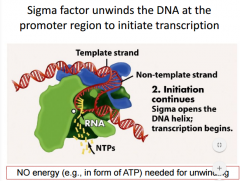
|
. |
|
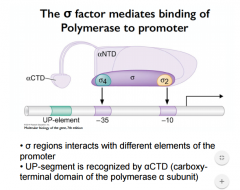
Describe |
UP element or upstream activating sequence: Sequence that is upstream (-75) from the promoter region where you can have different things help regulate transcription. RNA Polymerase Tail: RNA Polymerase has a long tail. The tail has a lot of syrines on it but the region (alphaCTD) end of the tail can bind with specific upstream elements and when it does, that can promote transcription. |
|
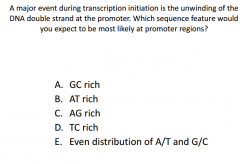
|
b. You'd expect more AT at region. Promoter regions are very AT rich. Weak promoters have less AT. |

